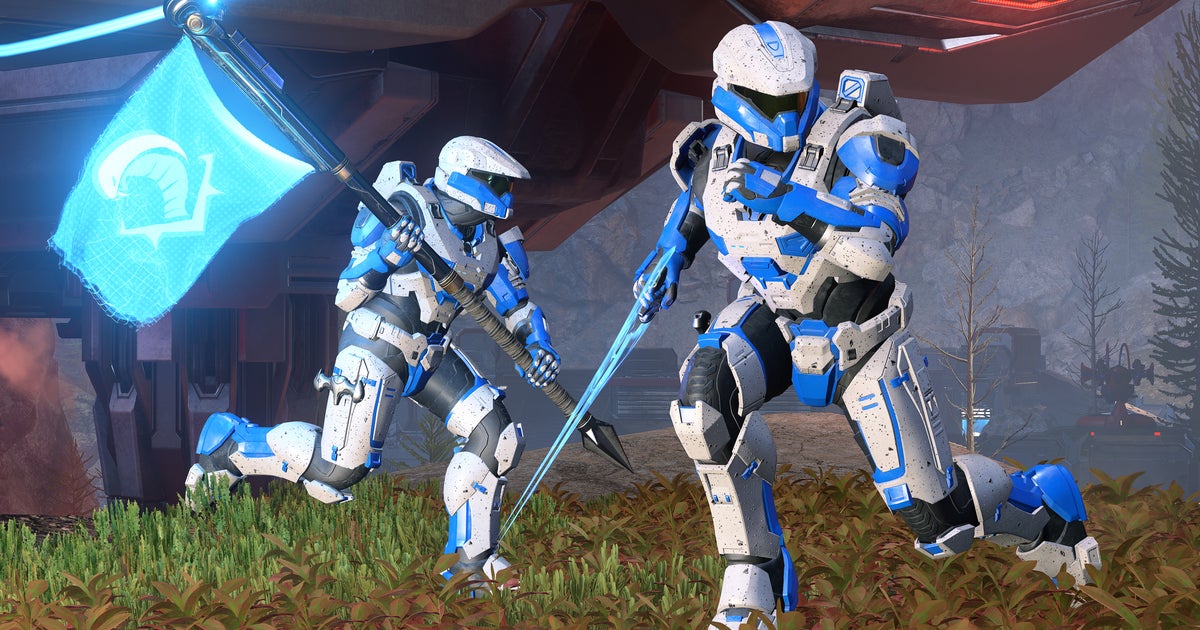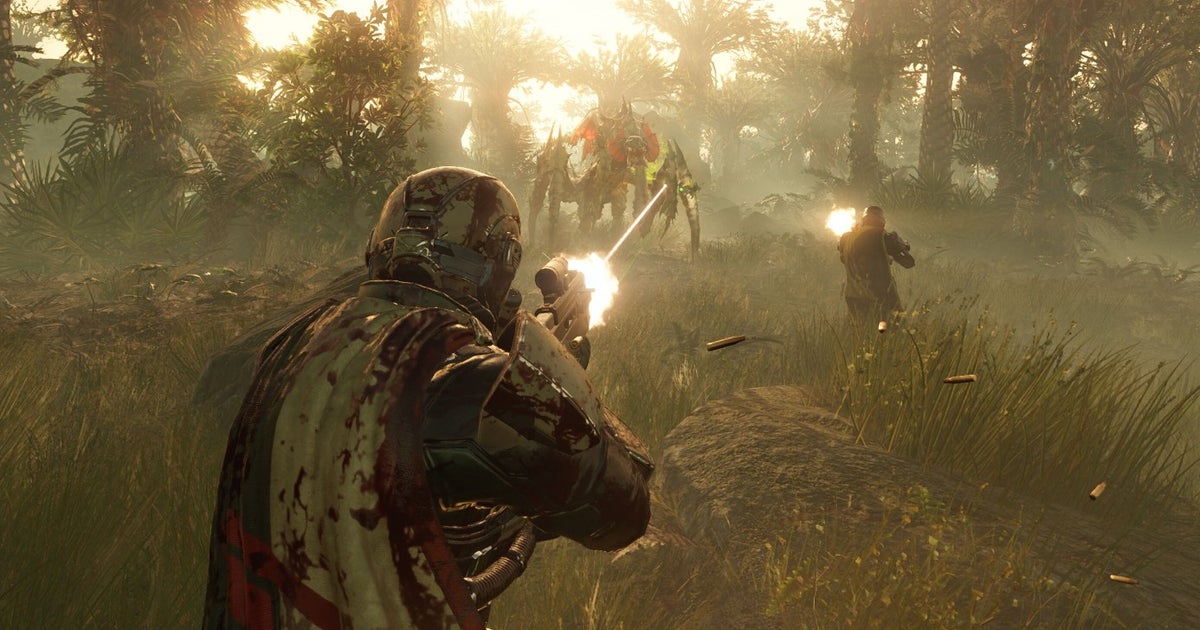[ad_1]
Commitment can be scarier than any ghost story. When I got married, I spent a lot of time leading up to the wedding borrowing grief from my future self. The prospect of ’til death do we part’ brought forward the stark idea that one day one of us would have to say goodbye to the other. I was suddenly and unexpectedly wracked with anxiety about the mortality of my loved ones, and playing Banishers: Ghosts of New Eden reminded me of this uncomfortable feeling. Antea and Red have each other, to hold and confide in and joke with – but Antea is a ghost, and they have to get ready to say goodbye. That’s the commitment they make to each other.
Banishers: Ghosts of New Eden sees Red and Antea, ghost hunters and life partners, called to settle a curse that’s fallen on the early Massachusetts settler colony of New Eden. The tight-knit, suspicious puritan community aren’t all convinced that the pair can help, seeing their arrival as too little too late – or insufficiently godly – after the loss of their community pillar to the ghost at the centre of the curse.
New Eden Town introduces you to life as a banisher: fighting violent spectres that have forgotten who they were, convincing benevolent ghosts to leave people to grieve in peace, and snooping in people’s belongings to get better answers to your questions. When the pair inadvertently walk into a trap, the townspeople’s suspicions are proved correct – Antea is killed, and the survivors scatter. To help her peacefully pass on, it will be a long journey to loosen the curse’s hold on the area to retrieve her body – and there’s the unthinkable option of taking that same journey to instead resurrect her, going against everything they believe as banishers. Death to the dead, and life to the living.
As Red and Antea travel through the region, they meet other haunted people. It’s up to them as banishers to provide closure, either by banishing or peacefully ascending the lingering ghost – or by blaming the living person for the situation, which sacrifices their life to provide closure for the dead instead, and contributes to the possibility for Antea to return.
Partway through Banishers: Ghosts of New Eden, I wondered if I’d committed too early. If it’s supposed to be a game about making difficult choices, had I robbed myself of the opportunity to make interesting decisions? I knew I wanted to help Antea pass on peacefully, as opposed to resurrecting her, and I also wanted to give a peaceful ascension to as many other ghosts as possible. It became apparent though that sticking to that commitment is the difficult part – not any one small choice in its own context.


Each haunting requires a little detective work. You ask the poor (or deserving) haunting victim some questions, before exploring for the sorts of clues that will let you speak to the ghost and find their side of the story. As a ghost, Antea can see things – hidden items and ghostly tracks – that Red can’t, but he needs to lead conversations with living people who, for the most part, can’t see her. It’s a nice symbiosis where you could frame their reliance on each other either way: Antea needs Red to speak to the living and open chests and doors, and Red needs Antea to reveal ghostly stains and clear spectral obstacles. They also rely on each other in conversation – discussing their investigations as they go on, and Antea providing input while Red questions people – adding life and depth to each haunting vignette.
When the mystery of a haunting is solved, and it’s time to confront everyone, Banishers: Ghosts of New Eden sidesteps the awkwardness around ‘balancing’ its morally grey choices by not always trying to. The choices themselves aren’t always hard, and some hauntings have uncomplicated villains – what makes them complex is your own underlying motivations.



On an individual level, it’s easy to condemn the ghost of a domestic abuser killed by his wife (far from the only deeply unpleasant ghost, as it should be noted that Banishers starts with a content warning for era-typical bigotry for puritanical New England). Within Banishers’s universe however, I couldn’t see how the more vindictive option – however satisfying – was going to spare anyone more pain or grief. He was dead, now, and soon he wouldn’t be able to hurt anyone anymore. Go become little blue sparkles.
I was pleasantly surprised to find that the peaceful option wasn’t framed as forgiveness, where it would have been easy to position that path as vaguely washing over a person’s crimes for some greater good. Smartly, Banishers: Ghosts of New Eden recognises that other people’s harms aren’t yours to forgive, even while you are playing at spectral judge.
.jpg?width=690&quality=75&format=jpg&auto=webp)
The choices you make aren’t really about how you assess any one individual haunting, but where you draw the line when the person you’re trying to be, and the strong emotions a question can bring come into conflict. It’s the type of question that Banishers poses from the very beginning: banishers are supposed to banish the dead, but will you keep true to that principle when it’s about your own love?
Antea’s death is a foregone conclusion at the start of the game, and because of this, I worried that she might just be a source of interesting mechanics, instead of a character in her own right. Instead, I was compelled by Antea, her flaws and her brilliance, her patience for those who deserved it and her rightful frustration at injustices across life and death. Her wry affection for Red, who returns it with his heart on his sleeve, made their relationship immediately convincing, and their journey all the more poignant. I’d probably consider sacrificing the equivalent of a small town for her too, in his position.


.jpg?width=690&quality=75&format=jpg&auto=webp)

While I didn’t sacrifice the town for her, taking the peaceful option doesn’t make everyone happy. Some find it unfair to see the people who haunted them, or tormented them in life, ‘rewarded’ with a gentler passing. This gets to be one of the unique things a ghost story can grapple with: what do you owe the dead, and what do you owe the living? While the dead pass on, the living have to continue with the consequences of your – and their – decisions.
These consequences don’t quite ripple out, but they do affect change, and you’re given the opportunity to check back on people later to see how they’re doing. That said, while Banishers: Ghosts of New Eden is technically an open world game, it’s remarkably linear for most of the time. This results in Red and Antea’s story being tightly paced, without long intervals with little development, but the side effect is that there are only really two points in the story where you’re encouraged to go explore the rest of the world, to go back and check in on people or indulge in the extras around its combat system, before being funnelled back into plot.
Up until the mid game, your gear and levelling are functionally gated by plot progress, as new skill trees rely on particular plot events, and gear upgrades rely on region or boss-specific resources. Until you’re fully set free in the world, Banishers: Ghosts of New Eden keeps a steady pace in combat. Once you are free, however, it’s up to you if you want to explore its more action-oriented side further, or enjoy it as a more narrative experience. I’ll admit: I took the middle road, and knocked the difficulty down a notch at this halfway point, leaving me with combat that was still an interesting challenge, but didn’t outright require me to grind to perfect my build.


I could, instead, have farmed for XP, and for the special limited resources used to upgrade your equipment, themselves only dropped by minibosses and challenge arenas. I could have scouted for special collectibles to unlock cursed chests of equipment in the hopes that they would synergise with my build better. The tactical part of me loves this approach, the short skill trees that are more about swapping boons than committing to one build forever, and the synergies you can combine between Red’s heavy melee attacks and Antea’s agile spectral abilities, but the combination of unreliable blocking thumbs and increasingly unforgiving hits made it harder to enjoy these elements without compromising.
When I go back to play it again and make different choices, I likely will dedicate this time to working around Banishers’s slightly unwieldy combat, but I appreciate that there are two lower difficulty settings (and two higher ones) that can be changed at any time for players who, like me, find themselves eventually out-paced – or who just struggle with the difficulty spikes around the bosses.
My fondness for ghost stories and detective mysteries were always going to influence me here, but more than that, I specifically related to Banishers: Ghosts of New Eden through the lens of who I am now. If Don’t Nod’s earlier game, Life is Strange, captured the big melodrama of my messy teenage feelings, then Banishers: Ghosts of New Eden finds me at the right time to be struck by its take on difficult commitments, the fear of loss and the profound harms we can do to each other when our principles go unexamined. In the end, I know its love story will haunt me for long after its parting words.
A copy of Banishers: Ghosts of New Eden was provided for review by Focus Entertainment.
[ad_2]
Source link



